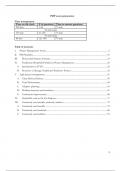Summary
Summary PMP in graphs, terms and formulas (logical explanation of everything you need to know for PMP 2024)
- Course
- Institution
Consider this document your ultimate cheat sheet for project management. It consolidates key information from the PMBOK 6th and 7th editions, the PMI website, and a requisite course for exam eligibility. The document is meticulously structured and includes a comprehensive table of contents for effo...
[Show more]



